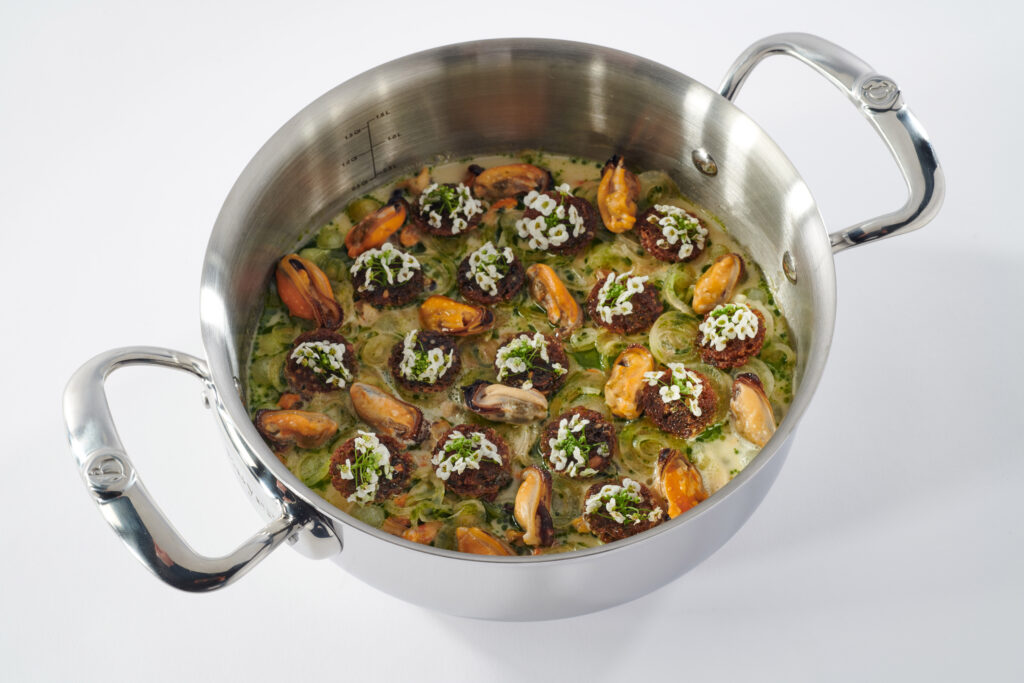The Lyon, France-based Bocuse d’Or, the world’s most prestigious and challenging culinary competition, is the main harbinger for global culinary trends; to discuss some of the latest trends, Estonian World sat down with chef Alexander Gureev, who represented Estonia in this year’s grande finale, Dimitri Demjanov, the president of Bocuse d’Or Estonia, and chef Anti Lepik, who served on the Bocuse d’Or jury.
According to the Estonian Bocuse d’Or finalist, chef Alexander Gureev, there are several trends that are quite popular. “For some time now, plant-based foods have been gaining popularity. For example, in the Baltic and Nordic countries, fermented foods are extremely popular, especially during the winter months,” he said, who prepared a completely plant-based appetiser as part of his competition dish in the final.
In conjunction with the general move towards greater environmental sustainability, minimising food waste is a trend that is also growing in importance. Considering that about 35% of all food in the world is wasted, it is important to start reducing and minimising food waste.
“Fortunately, we are seeing more and more restaurants using vegetables and fruit that may look slightly overripe but can still be used as high-quality ingredients,” Gureev noted, adding that home cooks should also start thinking about how to make the most of each ingredient.

Using local produce
People have always appreciated local produce, including the world’s top chefs competing in the Bocuse d’Or, also known as the culinary Olympics. The contestants have to use local produce from their country of origin. Team Estonia chose black rye bread by Muhu Pagarid, apple cider and apple cider vinegar and vegetables from Estonian organic farms.
According to chef Anti Lepik, who served on the Bocuse d’Or jury, Estonians have a knack for making good use of local produce and taking it to the next level by adding other flavours from around the world. “Personally, I like to experiment with chili peppers by adding them to sauerkraut,” Lepik said, adding that many Estonian restaurants like to add an Asian touch or spin to local dishes.
In addition to local produce, Bocuse d’Or competition dishes must also include compulsory ingredients which are always announced well in advance. This year, the compulsory ingredients were monkfish, eggs, pumpkin, scallops and mussels.
The Estonian candidate Gureev was excited about devising a new approach to use pumpkin. “In Estonia, pumpkin has always been a popular vegetable. I remember how in my own childhood, there was always a jar of my grandmother’s pumpkin salad on the table during wintertime,” he recalled.


A special focus on kids
According to Gureev, it is important that children are taught from an early age about healthy, high-quality food and how to prepare it at home.
Last year, chefs had to prepare a special menu of dishes inspired by take-away foods, whereas this year’s final task included a special menu for children. “The chefs were tasked with preparing a three-course menu that would be attractive for children in terms of both appearance and flavours,” Lepik explained. At the same time, they also had to make sure that the dishes were healthy and well-rounded.


While the main competition dishes were evaluated by a jury of top chefs, the children’s menu was scored by a jury of eight-to-ten-year-olds who awarded a special prize to the best menu.
In addition to the children’s menu, the contestants were given five and a half hours to prepare a competition dish using this year’s compulsory ingredient – monkfish. Since Estonia is a seafaring nation, the team’s tray was inspired by the sea, ships, sailors and the Vikings.

Bocuse d’Or as a culinary trendsetter
Among other things, the Bocuse d’Or is responsible for introducing the sous vide cooking technique (French for “under vacuum”), now used in many restaurants. This technique refers to prolonged cooking at low temperatures in a water bath, with the food cooked in a plastic pouch or a glass jar.
Other Bocuse d’Or-inspired additions to the culinary landscape include 3D food printers, silicone moulds, and dehydrators for fruits and vegetables.
About ten years ago, competitors liked to use smoke as a special effect to stand apart with the presentation of their competition dishes, and this year was a comeback for this approach. “This means it’s only a matter of time until restaurants will be reintroducing this technique as well,” chef Lepik said.

In the last 20 years, the Bocuse d’Or competition has introduced many novel culinary trends, such as sous vide, micro-pureeing with Pacojet, sublimation and dehydration, freeze-drying, 3D printing, children’s menus, new technologies for preparing vegetarian dishes and seafood, new additives and sauces, and more.
“As a result, Bocuse d’Or has become a kind of gastronomy lab that sets off new trends that have a strong influence the larger culinary community,” Dimitri Demjanov, one of Estonia’s grand restauranteurs and the president of Bocuse d’Or Estonia, said. “Bocuse d’Or serves as a testing ground for new flavours, raw materials and technologies that are later incorporated by restaurants and in home cooking.”
According to Demjanov, for a very long time, Bocuse d’Or has been a launchpad for master chefs and culinary enthusiasts, making their names known around the world and helping cultivate a global community of gastronomy enthusiasts.

In the 2023 final of the Bocuse d’Or, the Estonian team finished 13th, with Denmark taking gold, ahead of Norway and Hungary taking silver and bronze, respectively. The Bocuse d’Or grande finale takes place every two years in Lyon, France, with 24 slots for qualifying countries who progress through the preliminary regional finals.

